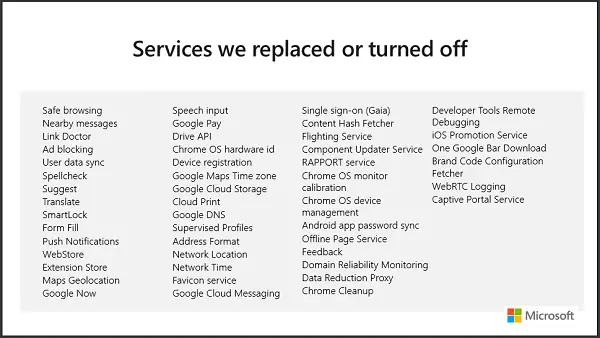Microsoft has started rolling out Chromium based Edge for Canary and Developer builds. Using Chromium as the base, Edge should work much faster, and not to forget will also support Chrome extensions. However, to our surprise, Microsoft has disabled many Chrome Services and Features in the new Edge. Let’s have a look at them.
Chromium Services & Features disabled in new Edge
This post takes a look at the following:
- List of services replaced or turned off in Chromium-based Edge
- Example of a replaced Chromium Service
- The key area of focus for Microsoft Edge
This situation is just like Chrome. Google expects Chrome users to use only Google Services. The same way, Edge users are supposed to be only communicating with Microsoft Services. The development team has identified such 50+ services and have been either turned off or replaced. It seems to be a necessary step to avoid conflicts. Below is the list of services removed:

- Safe browsing
- Nearby messages
- Link Doctor
- Ad blocking
- User data sync
- Spellcheck
- Suggest
- Translate
- SmartLock
- Form Fill
- Push Notifications
- Web Store
- Extension Store
- Maps Geolocation
- Google Now
- Speech input
- Google Pay
- Drive API
- Chrome OS hardware id
- Device registration
- Google Maps Time zone
- Google Cloud Storage
- Cloud Print
- Google DNS
- Supervised Profiles
- Address Format
- Network Location
- Network Time
- Favicon service
- Google Cloud Messaging
- Single sign-on (Gaia)
- Content Hash Fetcher
- Flighting Service
- Component Updater Service
- RAPPORT service
- Chrome OS monitor calibration
- Chrome OS device management
- Android app password sync
- Offline Page Service
- Feedback
- Domain Reliability Monitoring
- Data Reduction Proxy
- Chrome Cleanup
- Developer Tools Remote Debugging
- iOS Promotion Service
- One Google Bar Download
- Brand Code Configuration Fetcher
- WebRTC Logging
- Captive Portal Service
Example of replacement of Chromium Service
Microsoft has explained it in their slideshow how they did the changes with “Identity and Single Sign-On” Edge is expected to support Single-Sign-on with Microsoft Accounts (MSA) or Azure Active Directory (AAD). However, the architecture or Chromium is different from Edge.
Chromium sign-in dialogue is a WebView and uses REST calls to authenticate the user and create cookies.
- We use a client SDK, called OneAuth, that handles most everything for us: login UI, all types of SSO, MSA and AAD, etc.
- We modified the Sign-in flow by invoking EdgeAuthenticationManager in SigninViewController::ShowSignIn
- And to handle cases where the browser needs to make an authenticated service call, we specialized the OAuth2AccessTokenFetcher class: EdgeAccessTokenFetcherImpl
OneAuth takes care of the rest!
I am sure this will have an impact on Plugins which depend on Google Services. Either they will have to come up with the modified version or let it go. We will get to know that with time.
Key Area of Focus for Microsoft Edge:
As of now, the Chromium-based edge is focusing on these areas. Battery life is one of the critical areas. I can only hope Edge doesn’t take a toll on performance and battery as Chrome.
- Accessibility
- Editing
- Security
- ARM64
- Fonts
- Tooling
- Authentication
- Layout
- Touch
- Battery life
- Scrolling
- Web Standards
Apart from these, Edge comes with PlayReady DRM, Services integration and Single Sign-On. Play Read DRM makes it possible to stream secure content, i.e., DRM from services like Netflix, enables hardware decryption, supports LPAC and power savings. It is also Widevine ready.
Source: @TheWalkingCat.
Leave a Reply